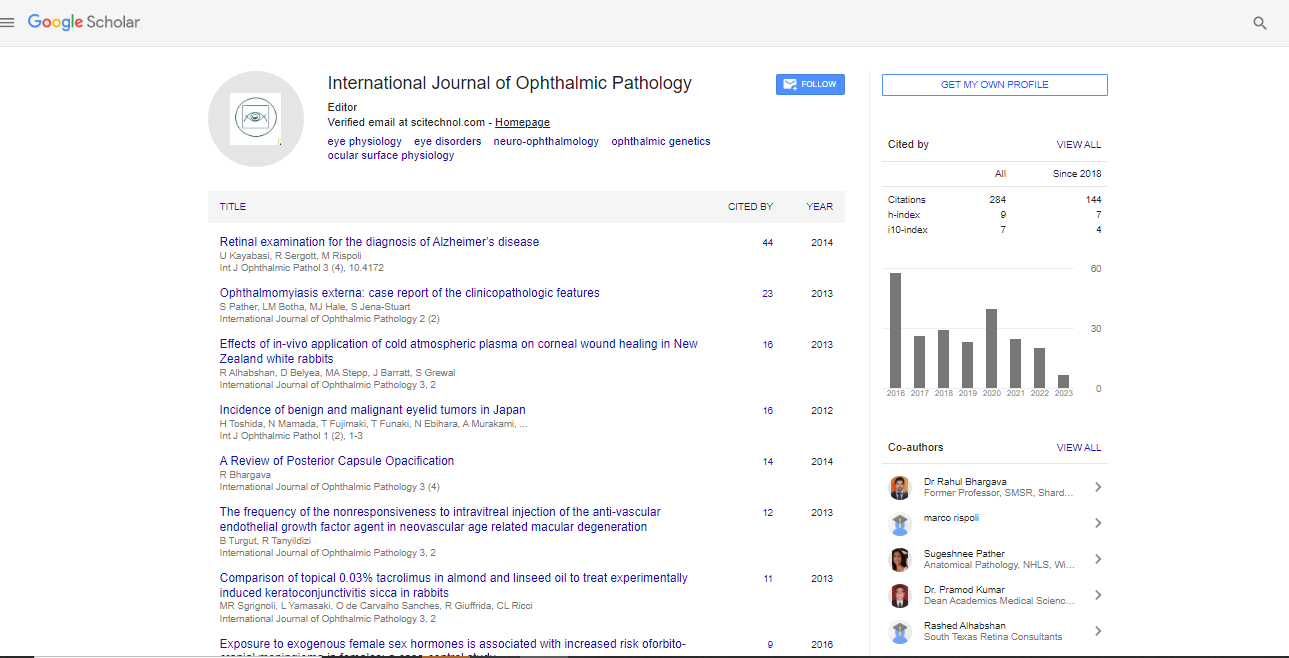Opinion Article, Int J Ophthalmic Pathol Vol: 12 Issue: 1
Better Eye Health through Managing Strabismus
Hein Medow*
1Department of Ophthalmology, Stanford University School of Medicine, Palo Alto, California, United States of America
*Corresponding Author: Hein Medow
Department of Ophthalmology, Stanford
University School of Medicine, Palo Alto, California, United States of America
E-mail: Heinmed@stanford.edu
Received date: 01 February, 2023, Manuscript No. IOPJ-23-95977;
Editor assigned date: 03 February, 2023, PreQC No. IOPJ-23-95977 (PQ);
Reviewed date: 17 February, 2023, QC No. IOPJ-23-95977;
Revised date: 24 February, 2023, Manuscript No. IOPJ-23-95977 (R);
Published date: 03 March, 2023, DOI: 10.4172/2324-8599.12.1.006
Citation: Medow H (2023) Better Eye Healt h t h roug h Managing Starismus. Int J Ophthalmic Pathol 12:1.
Description
Strabismus, commonly known as "crossed eyes" or "wandering eye," is a condition that affects the alignment of the eyes, causing them to point in different directions. It can result in blurred or double vision, reduced depth perception, and can have a significant impact on an individual's quality of life. However, with proper management strategies, it is possible to achieve better eye health and improve the visual outcomes for individuals with strabismus.
Early diagnosis: dentifying strabismus
Early diagnosis is critical in managing strabismus effectively. It is important to be aware of the signs and symptoms of strabismus, which may include misaligned or crossed eyes, double vision, squinting, tilting or turning of the head, and difficulty with depth perception. If any of these symptoms are observed, it is crucial to seek a comprehensive eye examination from an ophthalmologist or a qualified eye care professional. Early detection allows for prompt intervention and better visual outcomes.
Treatment options: Correcting eye alignment
The goal of managing strabismus is to align the eyes and restore binocular vision, which is the ability to use both eyes together as a team. The treatment options for strabismus depend on the severity and underlying cause of the condition and may include:
Eyeglasses: In some cases, eyeglasses with specialized lenses, such as prism lenses, may be prescribed to help correct the alignment of the eyes and improve vision.
Vision therapy: Vision therapy, also known as orthoptics or eye muscle exercises, is a non-surgical approach that involves a series of eye exercises and activities to strengthen the eye muscles, improve eye coordination, and promote better eye alignment.
Patching: Patching is a method used to improve vision in the weaker eye by covering the stronger eye with a patch for a certain period of time each day. This encourages the weaker eye to work harder and develop better visual acuity.
Medications: In some cases, medications such as atropine eye drops may be prescribed to temporarily blur the vision in the stronger eye, encouraging the weaker eye to work harder and develop better vision.
Surgical intervention: In more severe cases of strabismus, surgical intervention may be required. Eye muscle surgery involves adjusting the tension of the eye muscles to align the eyes properly. It is typically done on an outpatient basis and may be combined with other treatment approaches for optimal results.
Lifestyle modifications: Promoting better eye health
In addition to the above treatment options, certain lifestyle modifications can also contribute to better eye health in individuals with strabismus. These may include:
Regular eye exams: Regular eye exams are crucial in managing strabismus and monitoring the progress of treatment. It is important to follow the recommended schedule of eye exams as advised by the eye care professional.
Vision hygiene: Practicing good vision hygiene, such as taking regular breaks during prolonged near tasks, maintaining proper posture, and avoiding eye strain, can help alleviate eye fatigue and promote better eye health.
Vision habits: Developing healthy vision habits, such as maintaining proper distance from screens, holding books or devices at an appropriate distance, and avoiding excessive screen time, can reduce eye strain and promote better eye alignment.
Environmental modifications: Creating an environment that promotes good eye health, such as ensuring adequate lighting, minimizing glare, and maintaining a clutter-free workspace, can also be beneficial for individuals with strabismus.
Conclusion
Managing strabismus requires a comprehensive approach that includes early diagnosis, appropriate treatment options, and lifestyle modifications. With timely intervention and proper management, it is possible to achieve better eye health and improve the visual outcomes for individuals with strabismus.
 Spanish
Spanish  Chinese
Chinese  Russian
Russian  German
German  French
French  Japanese
Japanese  Portuguese
Portuguese  Hindi
Hindi 